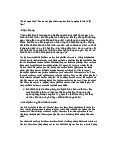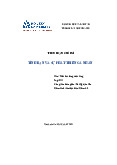






Preview text:
CRITICAL THINKING FINAL TEST
Topic: “Can Gen Z save the world?” with social issue: Fast Fashion
Part 1. Gen Z – Identity and values I. Identity
Generation Z, also known as Gen Z, is a term used to refer to people born between
1997 and 2012. Since it was born in the era of technology, the Internet exploded, Gen Z
has other names: iGeneration, Homeland Generation, Net Gen, Digital Natives, etc.
Currently, there are approximately 2.6 billion people in Generation Z, accounting for a
third of the world’s population. And in Vietnam, the Z gene has about 15-16 million
people, accounting for about 25% of the national workforce. It can be said that the Z gene
is the most potential generation now.
Generation Z is also referred to as the “citizen” of the digital age, has an economic
mindset and is hoped to be the leader in building and changing the developing world of
the future. We can identify Gen Z through the following characteristics: Connect socially The generation Need for global and show of digital connectivity yourself strong Always adapt to the Those who create environment, Fast and intuitive change and move new trends Influence in Ability to learn and The online the use create good content dating trend
According to Roberta Katz, a senior research scholar at Stanford's Center for
Advanced Study in the Behavioral Sciences (CASBS), Generation Z is a highly
collaborative cohort that cares deeply about others and has a pragmatic attitude about
how to address a set of inherited issues like climate change. Besides, she also thinks that
a typical Gen Zer is a self-starter who cares deeply about others, wants a diverse
community, works well with others, values flexibility, relevance, authenticity, and
leadership without hierarchy, and is saddened by problems like climate change but
willing to do the work that needs to be done to fix them. [1] II. Values
Generation Z always carries a source of boiling energy and heat, but compared to
previous generations, this generation has a new perspective.
According to the book “iGen: Why Today's Super-Connected Kids Are Growing Up
Less Rebellious, More Tolerant, Less Happy — and Completely Unprepared for
Adulthood — and What That Means for the Rest of Us” by Dr. Jean Twenge, iGen is
more interested in safety and tolerance than any other generation. She also write that they
"have no patience for inequality". In the interview from CSU, Dr. Jean Twenge said that
iGen had been born into a culture that is more focused on the self and less focused on
social rules than the culture their parents grew up in. People in [this society] are treated as
individuals instead of as members of groups. This makes everyone feel like they have the
same rights. This is one of the most important ideas of independence, and iGen shows that. [2] [3]
1. Gen Z and previous generations
During study, we found that the gap between Millennials (Gen Y) and Gen Z is not
too significant. In addition, we see many differences between the Z gene and the
generations of parents (Gen X) and grandparents (Silent Generation & Baby Boomers). [4]
From the past, in Viet Nam, the context of parents and grandparents generations is
war with a hard life and poverty. With a life filled with many turning points and
prejudices, their views and today's youth are completely different.
a. Consciousness of Generation
Generation consciousness studied by the social scientist Karl Mannheim is a
characteristic sign for recognizing the gap between generations. Those born in the same
period of time, experiencing events, changes, and changes in society will gradually form
the general consciousness of the generation. [5]
When people who were born during war want peace more than anything, the
Millennials and Generation Z are aware of the chances they have to improve themselves
and their jobs. They have dreams, dare and have the conditions to realize them.
Moreover, we think that not only in Viet nam but also other countries, in the past,
people in previous generations must listen to people who went before. The best child is
the child who is obedient to his parents. And her grandfather’s days were often shaped
with the thought that what parents taught was the best, that the children had nothing to do
but obey the teachings. If there is a thought or direction that is different from the crowd,
contrary to the parents' wishes, it is very difficult to accept, even if success is not necessarily recognized.
Nowadays, Gen Z still listen to what their parents say, but not to do what they say.
Instead, they should do in order to get advice and then choose their own path. Part of the
reason is that the parents have taken away the strict and unnecessary rules and controls
because they wanted to give the kids more freedom and let them grow up as they wish. [6] b. Language used
In Gen Z, many new languages were born, or also known as gen Z languages, such as
slang words, teencode, abbreviations, etc [5]. They were "invented" with the purpose of
making the conversation concise, which can add the fun part as young people
communicate with each other. Therefore, our grandparents and parents often don’t
understand the conversations of today’s young generation. c. Using technology
Unlike their grandparents and parents, people born in the age of the Internet boom and
technological science grew up in a time when technology was easy to use and adapt to. If
in the past, mail was the only means of communication, now it is just a phone call that
can be connected from one country to another.
The younger generation connects more easily through the phone, messaging apps, or
social networks. At the same time, they are also more independent in communication
when they are free to choose the means and ways. This makes them more independent
and different from their parents – people who are not technologically skilled. [5] 2. The main difference
Looking back, the most striking differences of the Z gene are shown in they are easy
to understand and empathize with social issues, such as cultural segregation, sexual
orientation, racism, etc., they are more concerned about mental health, psychological
problems, emotions, etc. Though past generations have taken up social issues, Gen Z are
more socially minded than previous generations. According to the Annie E. Casey
Foundation, Gen Zers are focused on seven key social issues: healthcare, mental health,
higher education, economic security, civic engagement, race equity, and the environment.
However, they are also often associated with a number of negative “marks” such as:
anxiety/depression generation, susceptible to psychological problems, too covered, etc.
Part 2. Gen Z’s legacy
In the age of the Z gene, a lot of trends and symbols were born to meet, attract young
people. Among them, fast fashion appears as a controversial stream and completely
attracts today’s young people. We noticed the potential in this social issue so this is why
our team chose fast fashion as a co-research issue on “Generation Me.” I.
Definition and advantages of fast fashion
1. Definition of fast fashion
Fast fashion is a new profitable business model of
global fashion industry. To be more specific, fast fashion
means that producing quickly a large amount of fashion
clothes by using cheap ingredients. So these fashion
clothes are quite cheap and will be changed continuously
in every seasonal collection of fashion brands, which is
very suitable for almost everyone, especially Genz. [7]
2. Advantages of fast fashion
First of all, customers can afford many new beautiful
clothes without paying much money, especially Genz who
will not have much money but high fashion needs. Beside,
those who needs to change appearance frequently including
Genz will also need to buy more clothes. Then, fast fashion
brands will be the best choice because of the variety of
goods in each of their seasonal collection.
Next, fast fashion will definitely brings many benefits to many fashion brands. Some
fast fashion brands like Zara, H&M, Uniqlo, Topshop,... can make huge profits by
producing poor quality products without losing customers. Many new fashion designs
produced continuously at low price will make customers excited because of changes,
thereby increasing the demand of clothes shopping in each buyer. [8]
3. Disadvantages of fast fashion
Firstly, H&M is a major fast fashion company has declared its commitment to being
a sustainable business and minimizing its negative impact on the environment. H&M has
initiated many old clothing recycling programs such as Clothing Collection and Close the
Loop. According to an article in The Guardian, the company has been accused of burning
tons of used clothes it collects from customers in exchange for coupons, in addition to
shipping old clothes across West Africa and those that aren't usable end up in the
country's landfills, as you can see the picture and the clothes that are not torn will be sold
back to the poor people here. [9]
Secondly, the nature of Fast Fashion is massive, continuous, non-seasonal
production, which also means that brands need a lot of manpower at their processing
workshops. Therefore, they are not afraid to accept women and children as long as
production productivity corresponds to consumer demand, even, the more products to sell, the more.
Although these problems are extremely serious, if fast fashion brands announce
discounts, society will continue to consume these items.
As a Hoa Sen university student, I find out that I absolutely do not tolerate such
behavior and do not encourage anyone to buy fast fashion. II.
The impact of fast fashion on work
The nature of fast fashion is mass production, which means that the factory must
have many workers, so they do not mind accepting women and children as long as the
production capacity meets the needs of consumers. In addition, because the price of fast
fashion is very cheap, workers have to be exposed to harmful chemicals that affect their
health, and the wages for each product are very little, so it is considered labor
exploitation. So why do we always have to follow fashion so that we are indirectly
exploiting other people's labor?
In addition to the above reasons, fast fashion also offers unsurpassed quality,
materials are not guaranteed, most of these designs are often copied from others,
supporting these products as indirectly for the infringement of intellectual property rights
and these not only harm the health but also the morale of workers or consumers. So
instead of using fast fashion, we need to choose carefully and choose the right one for ourselves. III.
Treatments based on the Z gene's viewpoint
These are some solutions to reduce fast fashion: Buy less fast fashion Buy higher-quality clothing
Buy from ethical fashion brands Shop second-hand clothing
Rent your clothes for special occasions
Swap pieces with friends and family Reuse, repurpose, and up-cycle Donate your unwanted clothes
Based on Gen Z's perspective, we should limit and completely boycott fast fashion. IV.
What's the legacies that gen z can leave behind?
Equality and collectivism are attributes that Gen Z strive to achieve. we are living in
an era where technology and communication are really interlinked leading to possible
loss of nature and no, especially for young people like us who love peace as well as
equity, so the legacy that we can bring to the world is a modern vision so that future
generations can develop a better way of fairness and equality in all things situation.
Finally, is environmental practices and codes of conduct. These things for us gen Z
are very necessary to be able to pass on to future generations, according to Ajzen's
Intended Behavior Model and Boztepe's Research Model as well as many other models
based on In the magazine "Factors affecting green consumption behavior of Generation
Z" in Vietnam, we have shopping factors to choose greener items to raise the awareness
of preserving and protecting the environment. Although these are just mechanical
statistics, it also shows that our gen Z's level of consciousness and behavioral awareness
is getting higher and higher so that the next generations can also learn. [10] [1 1] V. Conclusion
In conclusion, gen z is the generation, which is extremely active, curious and have
an ability to follow trend very quickly. Therefore, the effect of gen Z to fast fashion is
considerable and significant, including benefits or drawback, all of them bring
meaningful and important value to fast fashion. Lastly, this is point of view of my group’s
members who are gen Z about fast fashion, the kind of fashion appear at the same time with gen Z. Part 3. References
[1] Witte, M. D. (2022, 01 03). Stanford News. From news.stanford.edu:
https://news.stanford.edu/2022/01/03/know-gen-z/
[2] Twenge, D. J. (2017). iGen: Why Today's Super-Connected Kids Are Growing Up
Less Rebellious, More Tolerant, Less Happy — and Completely Unprepared for
Adulthood — and What That Means for the Rest of Us.
[3] Marcos, A. (2017, 08 22). Move Over, Millennials: How ‘iGen’ Is Different From Any
Other Generation. From The California State University:
https://www.calstate.edu/csu-system/news/Pages/Move-Over-Millennials-How-
iGen-Is-Different-Than-Any-Other-Generation-.aspx
[5] Bich, N. (2022, 04 01). The Generation Gap: Khoảng Cách Thế Hệ Là Gì? From
glints: https://glints.com/vn/blog/khoang-cach-the-he-generation-gap-la-gi/
[6] Keng, T. L. (2017, 07 16). So sánh thời "ông bà tôi" và hiện đại: Cách theo đuổi đam
mê. From cafebiz: https://cafebiz.vn/so-sanh-thoi-ong-ba-toi-va-hien-dai-cach-
theo-duoi-dam-me-20170716150946418.chn
[4] Hoefel, [. T. (2018). ‘True Gen’: Generation Z and its implications for companies. McKinsey&Company.
[7] Nhu, K. (2021, 07 19). Fast Fashion là gì? Lợi ích & những vấn đề của “thời trang
nhanh”. From Hải Triều: https://haitrieu.com/blogs/fast-fashion-la-gi/
[8] Rachel Bick, E. H. (2018). The global environmental injustice of fast fashion.
[9] Bleuming. (2023, 06 23). Fashion Industry Giant H&M Faces Major Recycling
Scandal. From Bleuming: https://blearning.edu.vn/fashion-industry-giant-hm- faces-major-recycling-scandal
[10] Bond University. (n.d.). From Issuu:
https://issuu.com/bonduniversity/docs/mb9917_arch_edition_29_final_- _web_/s/14068539
[11] (n.d.). From https://b.vjst.vn/index.php/ban_b/article/view/1099/998


